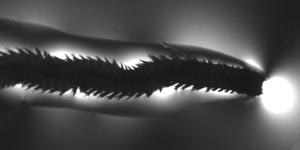Kelly Dorgan
Research Projects
Burrowing in mud
Marine worms burrow through muddy sediments by cracking rather than deforming them or simply eating their way through. Muddy sediment is cohesive and behaves like an elastic solid that fractures under forces exerted by animals. The worm's burrow is a tongue-depressor-shaped crack in which the worm is compressed dorso-ventrally by the elastic burrow walls. The polychaete Nereis virens everts its pharynx to exert a force perpendicular to the direction of motion. That force, exerted against the wall of the burrow, is focused at the tip, causing the crack to propagate and the burrow to extend.

The mechanics of burrowing depend on material properties of the sediment (elastic modulus and critical stress intensity factor).
Seawater gelatin has similar mechanical properties (ratio of stiffness to fracture toughness) and is used as an analog for muddy marine sediments. We have found that worms will burrow if they are placed in an already formed crack and given some gentle prodding. Gelatin is birefringent, enabling use of photoelastic stress analysis. Stress in a birefringent material reorients light in the directions of maximum and minimum principle stress. When the gelatin is between crossed polarizers, no light passes through except where the material is stressed (and light is reoriented to pass through the second polarizer). The area and intensity of light passing through the crossed polarizers is proportional to the force being applied to the gelatin. I have measured forces exerted by Nereis burrowing in gelatin, then used finite element modeling to convert measured forces to those exerted by worms in muddy sediments based on the difference in stiffness (E) between the two materials. Calculated forces are much smaller than forces measured in previous studies, raising questions about the reputed high energetic cost of burrowing.